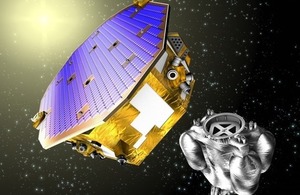LISA Pathfinder set for launch
Europe’s technology demonstrator for detecting gravitational-waves, is set for launch tomorrow (2 December at 04:15 GMT).

Artist's impression of LISA Pathfinder. Credit: ESA.
The spacecraft will launch on a Vega rocket from Europe’s Spaceport in Kourou, French Guiana.
The UK-led spacecraft will help to open up a completely new observational window into the gravitational Universe, by testing new technologies needed to measure gravitational waves in space. Predicted by Albert Einstein, these waves are ripples in the curvature of spacetime produced by massive celestial events, such as the merging of black holes.
While ground-based searches for these elusive messengers of gravity have been under way for the past few decades, a gravitational-wave observatory in space would open up new possibilities in this quest.
Detecting gravitational waves would also be an additional confirmation of General Relativity, and greatly enhance our knowledge of the most powerful phenomena in the Universe.
The UK’s involvement in LISA Pathfinder’s technology demonstration payload and the operational phase of the mission is funded by the UK Space Agency and was formerly funded by the Science and Technology Facilities Council (STFC). Airbus Defence and Space in the UK is the prime contractor for the mission, having built the spacecraft, as well as being the LISA Test Package (LTP) architect, on behalf of ESA and the participating Member States. SciSys UK Ltd developed the satellite’s on-board software and UK scientists from the University of Birmingham, the University of Glasgow and Imperial College London have designed and built elements of the innovative and complex LTP. It is the first ESA science spacecraft led from the UK since Giotto.
Among the anticipated sources of gravitational waves are supernova explosions and double black holes. These objects are thought to be associated with overwhelmingly powerful events. For example, the energy released in gravitational waves during the last few minutes of the merging of just one pair of supermassive black holes is comparable to the total energy emitted as light by all stars and galaxies across the cosmos over the same time. Scientists are also looking forward to discovering even more, unexpected cosmic sources once they are able to ‘listen’ to the Universe on this new channel.
Despite the enormous energy release in gravitational waves produced by these mighty cosmic events, they should only cause tiny perturbations to the fabric of spacetime. Instruments built to detect them must be capable of making exquisitely precise measurements of extremely small changes in distance between two reference objects.
Typically, for a space-based gravitational wave observatory, this will mean seeing the distance between two ‘test masses’ separated by around a million kilometres changing by about a millionth of a millionth of a metre.
This requires extraordinary measurement techniques using lasers, with the test masses flying freely in space, each shielded by a surrounding spacecraft from all extraneous influences, such as the solar wind.
LISA Pathfinder is designed to prove these extraordinarily precise techniques in space on a much smaller scale, in order to pave the way for a potential gravitational wave mission in the future.
Watch the launch
In cooperation with Arianespace, ESA TV will provide live satellite relay of the launch.